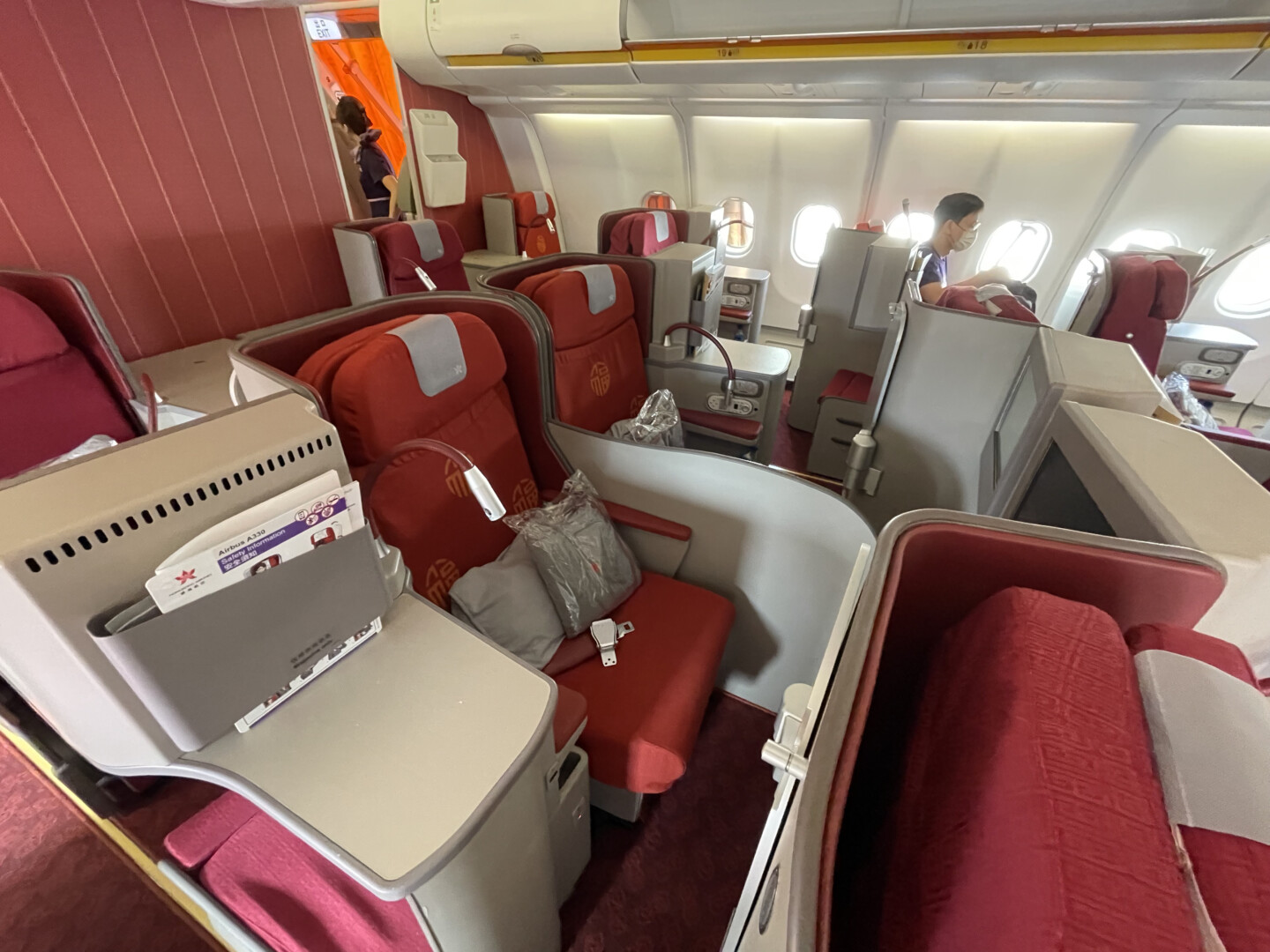|
YTHK'S VERDICT
This airline needs a couple of re-investments to truly get back "on the map" (such as WiFi, menus and better catering), though they provide a pleasant product with consistently low pricing |
3.5
|
In August 2023 I flew Hong Kong Airlines’ business class from Tokyo Narita to Hong Kong. Hong Kong Airlines has been through a rough patch, with lack of demand due to Hong Kong political instability closely followed by the COVID-19 pandemic. The airline had been thrown a lifeline by parent company Hainan Airlines, allowing it to stay in business, though unfortunately it had to cut many amenities, including their inflight entertainment system, and at one point, catering.
Many of these have been restored as the airline has slowly regained health. Actually, I’ll point out a couple of features that have since been reinstated to the product, as it did take me a while to get around to writing this review. I wrote up my first impressions of the product a few days after I flew it, which you can find here.
Here’s a more comprehensive review, where you’ll be able to follow along with my flight. I’ll detail the ground experience, seat, catering, amenities, service, and more.
Booking Hong Kong Airlines Business Class
I was flying with my parents and sister, and booked this Hong Kong Airlines flight with cash, where this one-way flight cost HK$3,642 (£371) per person. For a flight in business class between Tokyo and Hong Kong over summer, this is an absolute steal – in comparison, a Cathay Pacific roundtrip would’ve cost upwards of HK$20,000 (£2,036). I didn’t end up flying Hong Kong Airlines on the outbound as I miraculously found four business class seats from Hong Kong to Tokyo Narita on a day that worked for us – this was on a regional 777, and I won’t be reviewing the flight (here’s a review of Cathay Pacific’s regional business class I’ve written recently). I credited miles to Hong Kong Airlines’ own programme, the Fortune Wings Club, though I doubt I’ll be using those miles anytime soon.
Our flight itinerary was as follows:
16/08 Hong Kong Airlines 609 Tokyo Narita – Hong Kong dep. 15:55 arr. 20:00 [Business]
Hong Kong Airlines’ Business Class Ground Experience
We arrived at the airport’s Terminal 1 at around 2 PM, ahead of our flight at 3:55 PM. Narita Airport is starting to look a lot nicer than it used to, and the immigration facilities were very easy to use as well.
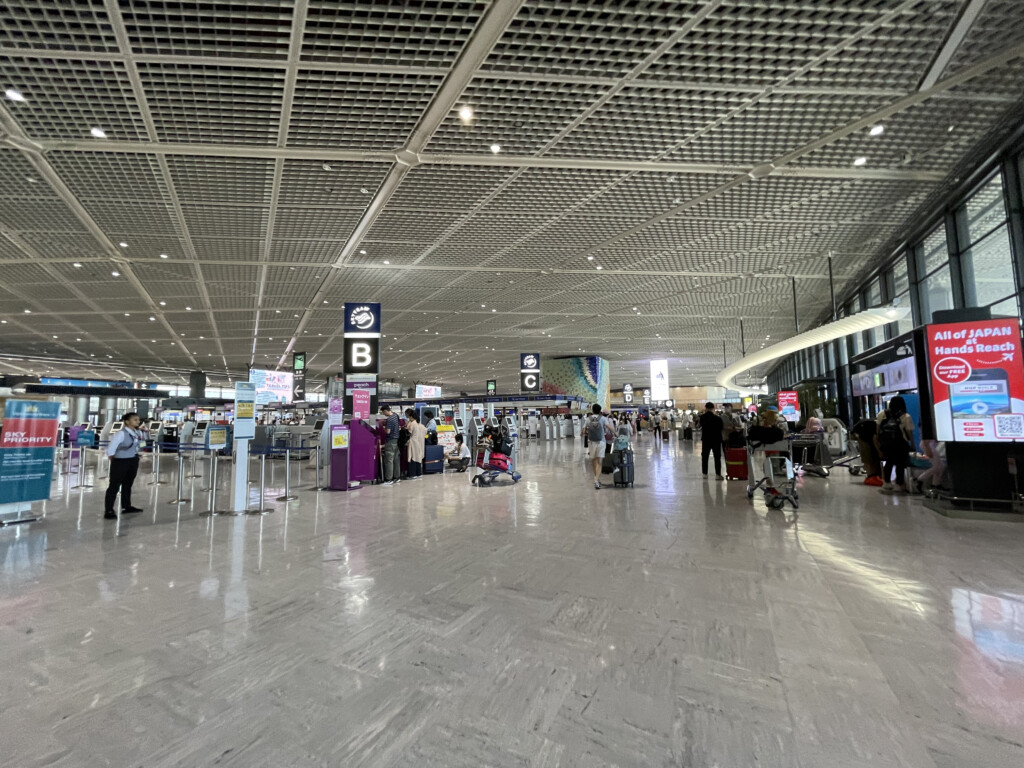
Narita Airport Terminal 1 Check-in Hall
Hong Kong Airlines offers online check-in, though unfortunately IT isn’t great – it took a long while for me to figure out how to save a boarding pass to my wallet. I also wasn’t able to check my sister in, as she was under 18 – despite the fact that she was travelling with three adults on the same reservation. The airline does offer a generous 40 kg baggage allowance to business class passengers though, which is the same as what Cathay Pacific offers.
Hong Kong Airlines uses the Narita Premier Lounge, which I’ll review in a separate post. Here’s a view of the Hong Kong Airlines A330 that we were able to catch from the lounge.
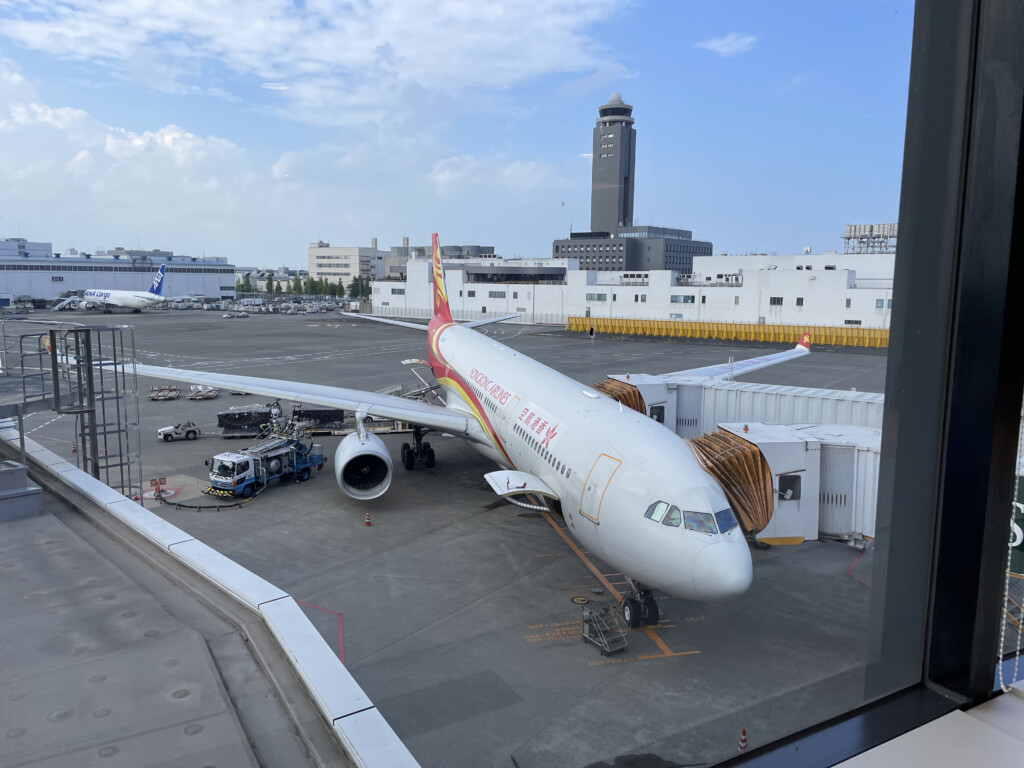
Hong Kong Airlines A330 at Narita Airport
At Hong Kong Airport, the airline uses the Club Autus lounge, which has recently reopened.
As you’d figure, our gate wasn’t far from the lounge – in fact, it was right below. Boarding was scheduled for 3:15 PM, though was moved forwards by 10 minutes to 3:25 PM, as you can see from the signage below.
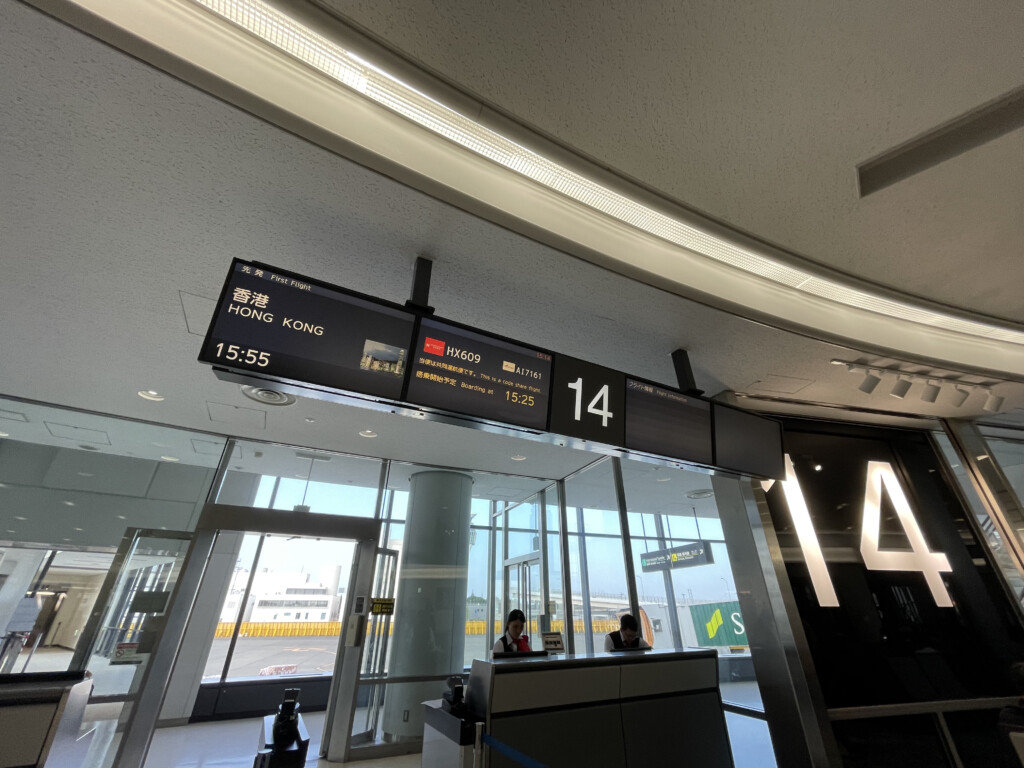
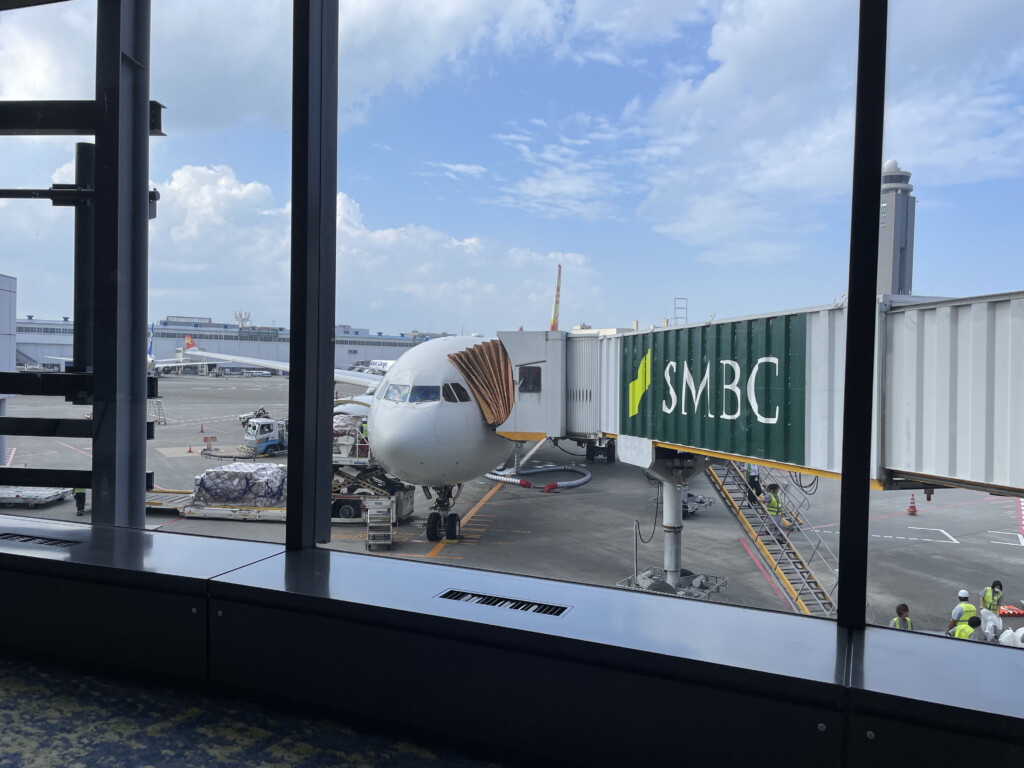
Departure Gate at Narita Airport and View of Hong Kong Airlines A330
As you’d expect from an airport in Japan, boarding did start smack bang on time at 3:25 PM, and I made my way onboard the Hong Kong Airlines A330.
Hong Kong Airlines Flight HX609
Wednesday, August 16, 2023
Origin: Tokyo Narita (NRT) T: 1 Gate: 14 Dep: 15:55 (16:00)
Destination: Hong Kong (HKG) Gate: 28 Arr: 20:00 (19:25)
Duration: 5 hr 5 min (4 hr 25 min)
Aircraft: Airbus A330-300 Reg: B-LHH
Seat: 20K (Business Class)
I boarded through the second set of doors, and turned left into Hong Kong Airlines’ business class cabin.
Hong Kong Airlines A330 Business Class Cabin and Seat
Hong Kong Airlines features a staggered configuration in business class, with 32 fully flat bed seats spread across eight rows. All rows are in a 1-2-1 configuration, providing direct aisle access.
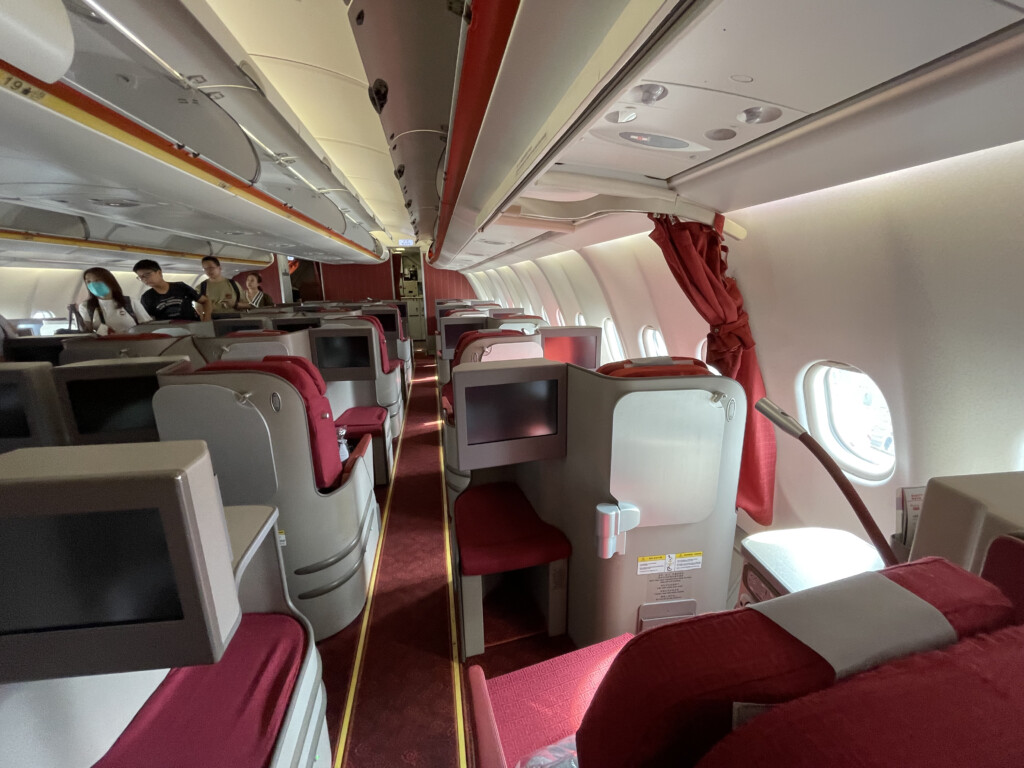
Hong Kong Airlines A330 Business Class Cabin
You’ll be familiar with these seats if you’ve flown any of Thai Airways, Emirates, Iberia, or the like – many other airlines also use these seats. As with staggered seats, some seats are positioned closer to the window, which is my personal preference. Here’s 20K, the seat I picked for myself (in fact, I picked these window seats for everyone in the family, despite them being two rows apart from each other). These are the A and K seats in this configuration, featuring in rows 12, 16, 18, and 20 (Hong Kong Airlines skips rows 13 and 14).
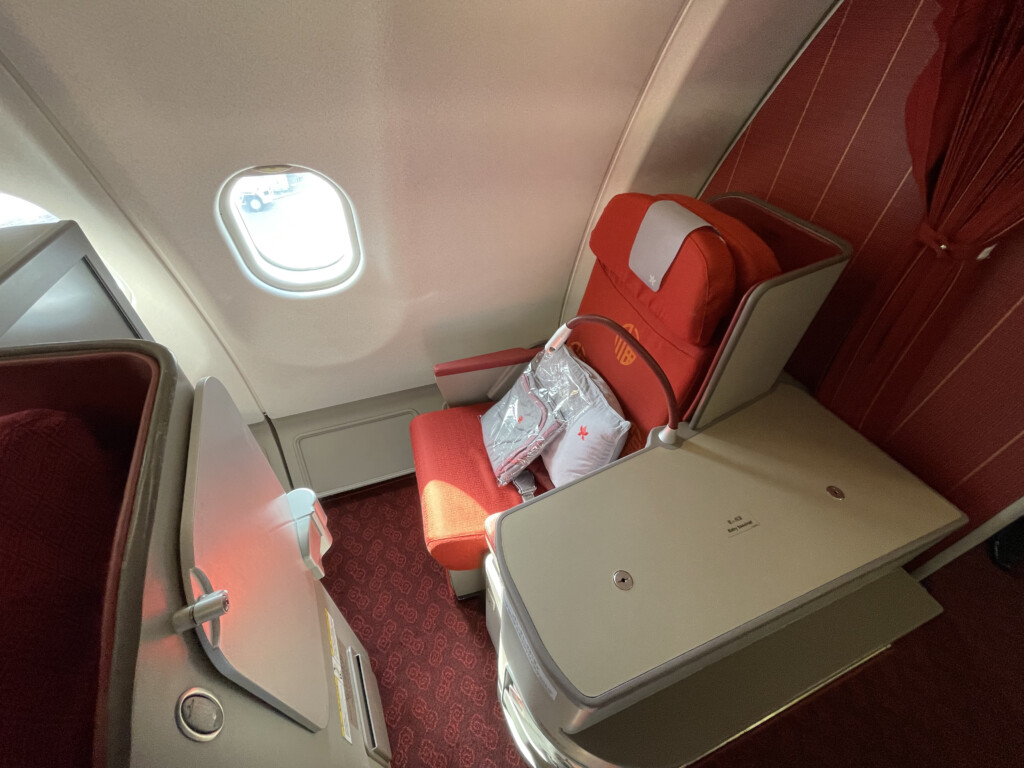
Hong Kong Airlines A330 Business Class Seat 20K
I find the aisle-side seats in alternate rows to be a lot less private – your seat console is between you and the window, so you basically feel like you’re sitting in the aisle. These are the C and H seats situated in rows 11, 15, 17 and 19.
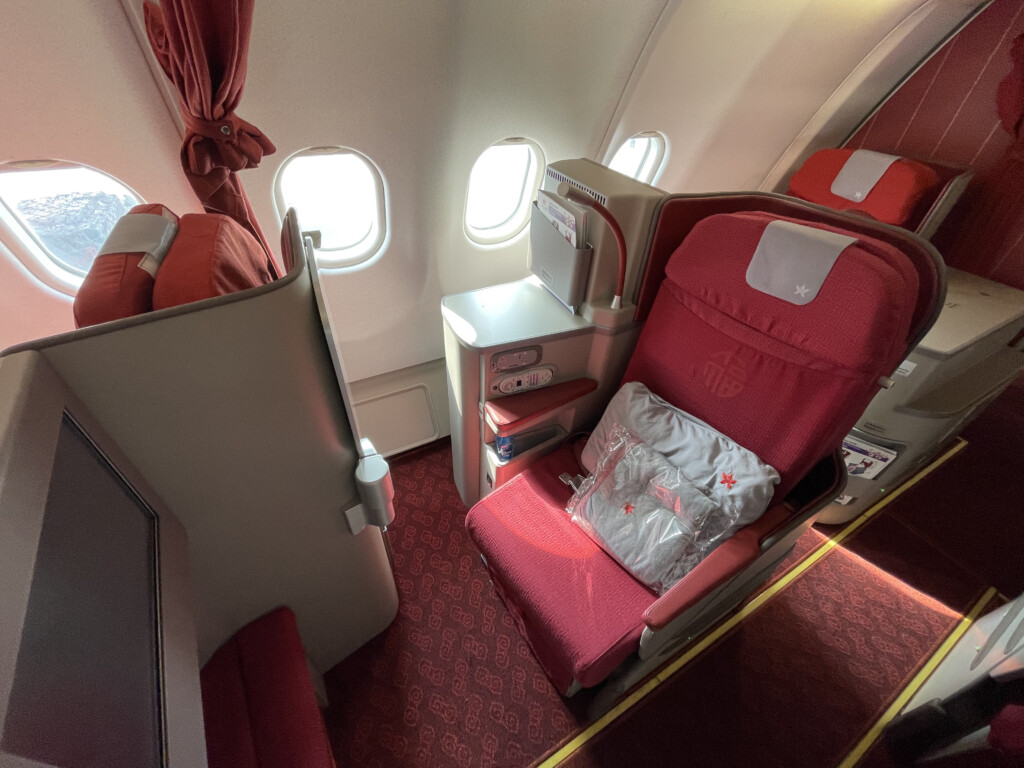
Hong Kong Airlines A330 Business Class Seat 19H
Then there are center seats which are closer together, the E and F seats in odd numbered rows. I’d be fine having a chat with a really good friend in one of these seats if we didn’t travel together often, though would pick a window in almost all other cases. They’re very close to each other, so you don’t get much more shoulder space as you otherwise would in economy.
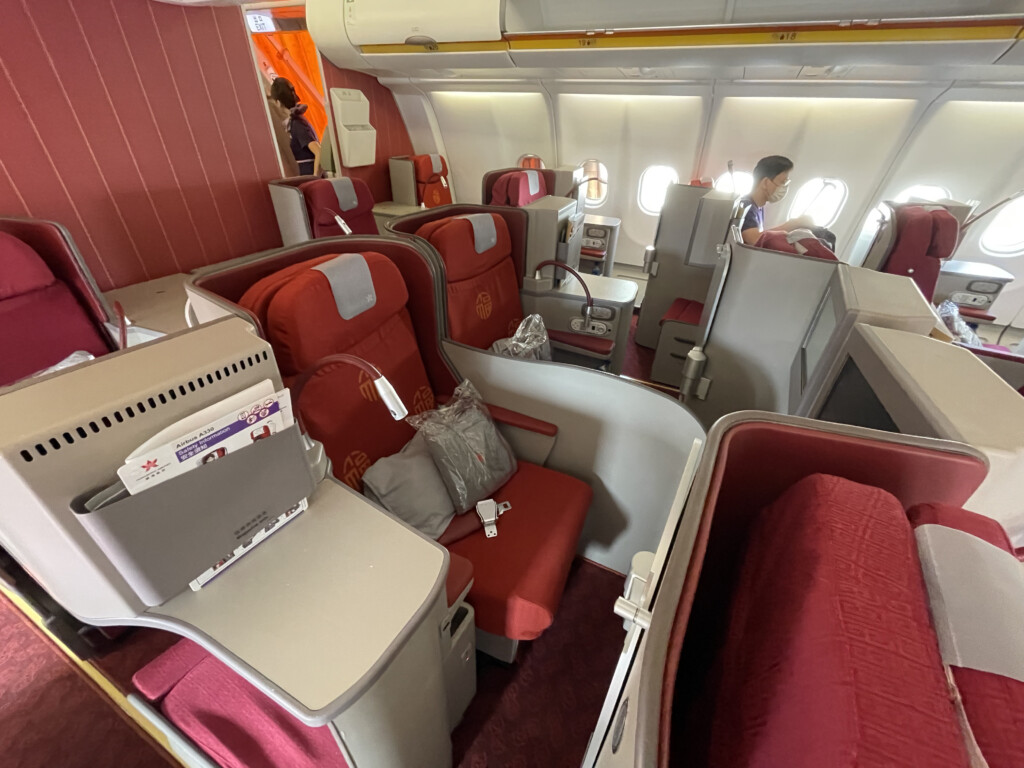
Hong Kong Airlines A330 Business Class Honeymoon Seats
Thankfully if you’re seated next to a stranger, you do have the option of raising the center partition, so there’s at least a little bit of separation.
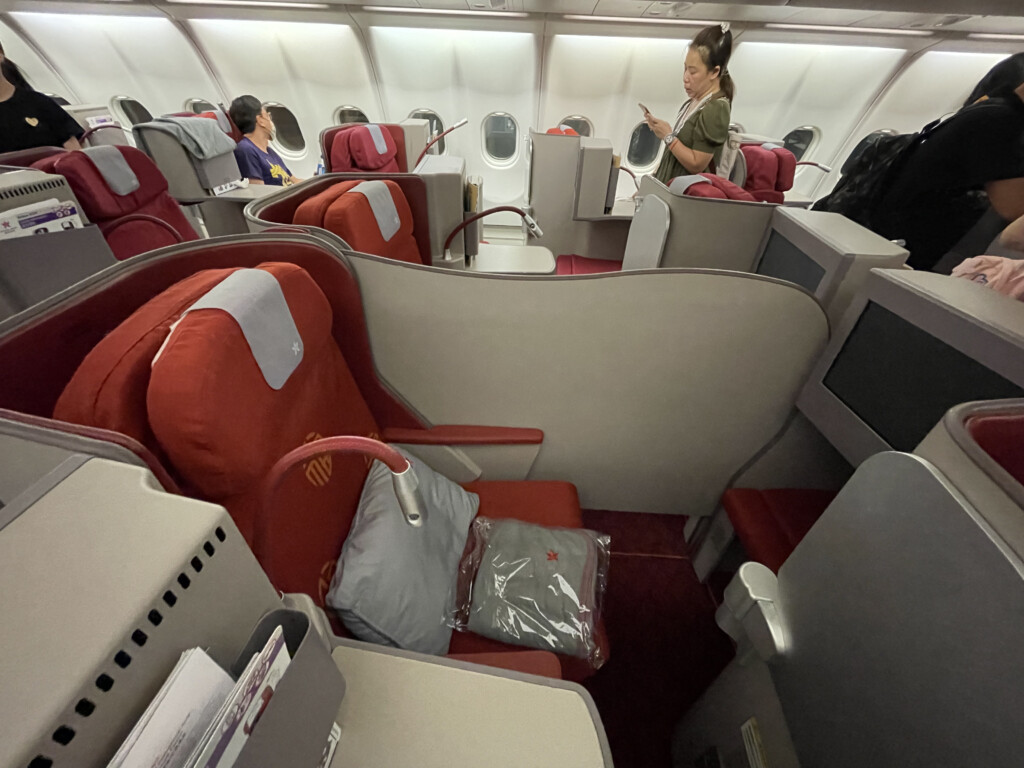
Hong Kong Airlines A330 Business Class Center Partition for Honeymoon Seats
These honeymoon seats come in alternate rows, whereas in the other rows the two seats are closer to the aisle (these are the D and G seats in the even-numbered rows).
Back at my window seat, 20K, I found my seat console to be on the left, featuring some seat controls (including lumbar support controls), and an entertainment screen remote. While the entertainment screen wasn’t turned on on this flight, I could still use the remote to turn on my reading light, or press the call button.
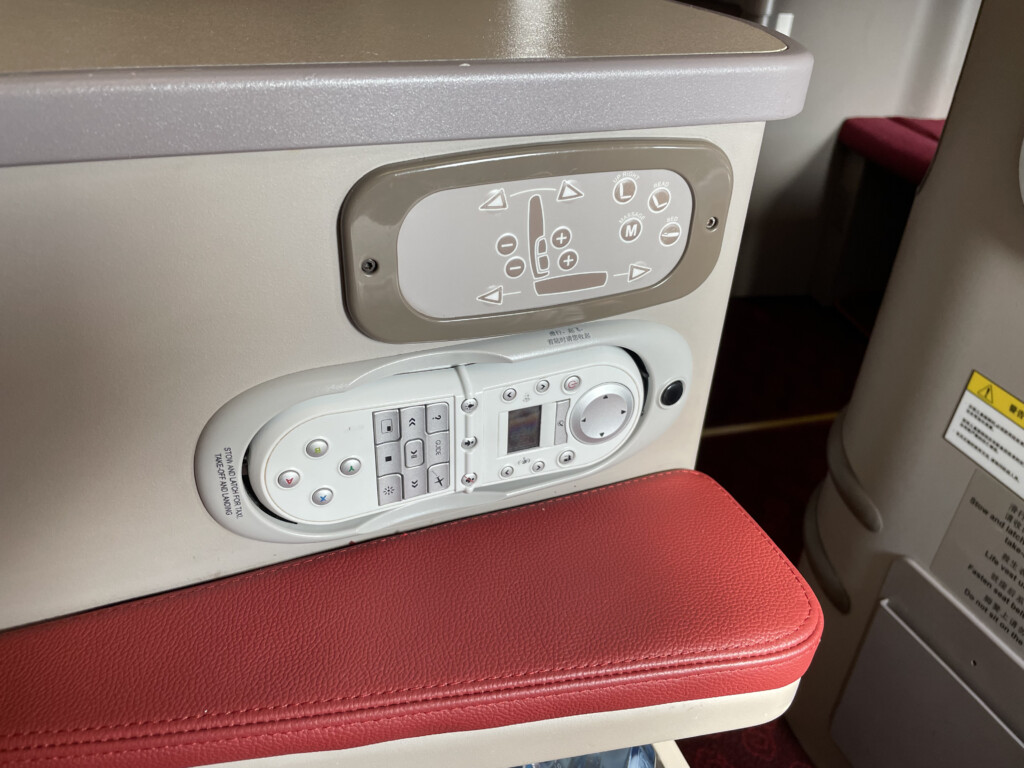
Hong Kong Airlines A330 Business Class Side Console
As you’d expect from such a configuration, the seat does turn into a bed. That’s fairly impressive, given that Hong Kong Airlines no longer operates flights over six hours.
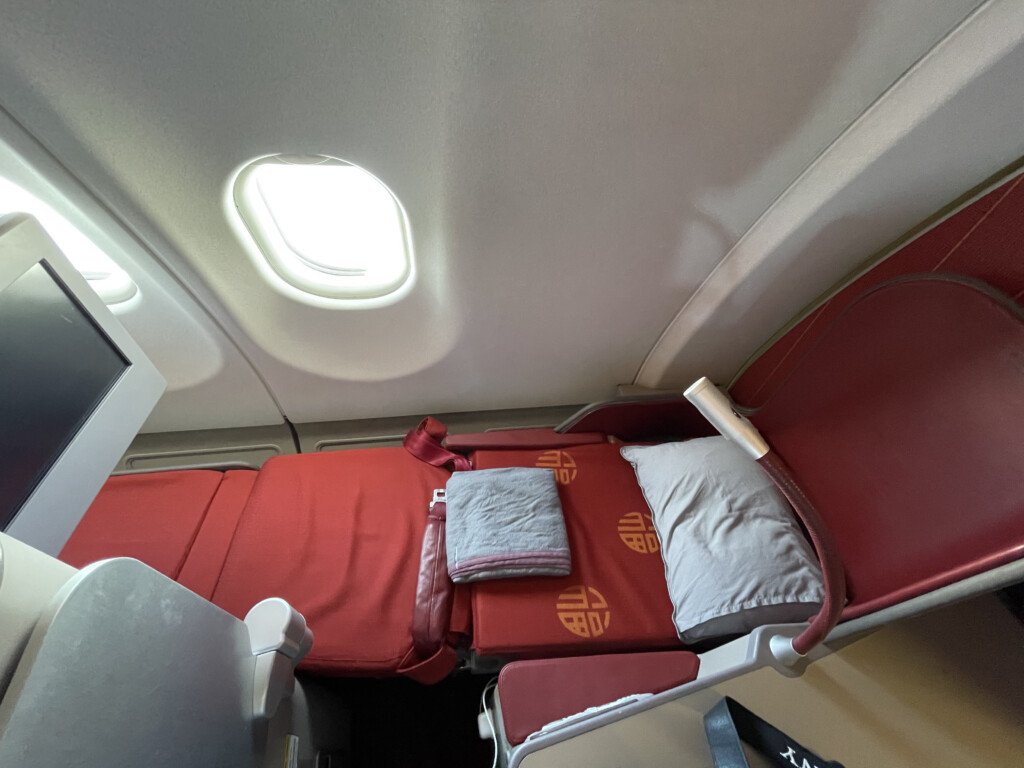
Hong Kong Airlines A330 Business Class Bed
Next to me was a reading light. Note that my seat was unique in that it featured an extra large storage table, as it would’ve doubled as a baby bassinet if a baby was onboard (in which case I would’ve been repositioned for the mother to sit there).
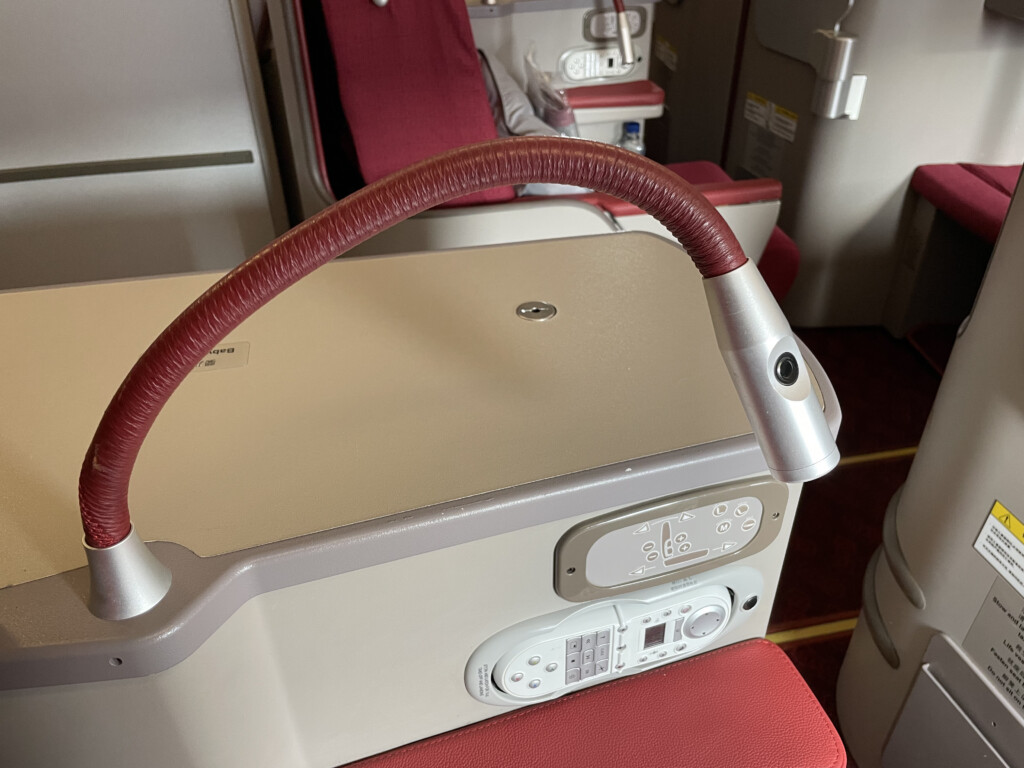
Hong Kong Airlines A330 Business Class Reading Light
The seat also featured a working power port, located by my left leg. There was no USB charging of any sort, however.
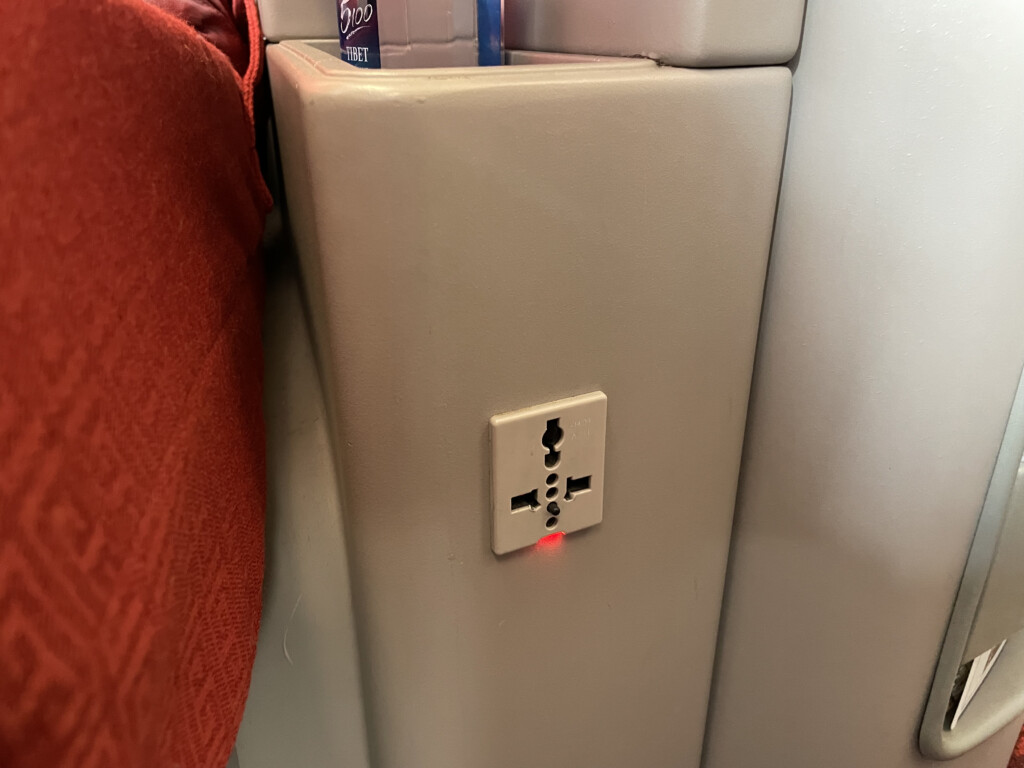
Hong Kong Airlines A330 Business Class Power Port
The tray table folded down from in front, and was sturdy, though it wasn’t bi-fold. I could swivel it if I wanted to use the bathroom while my tray table was deployed.
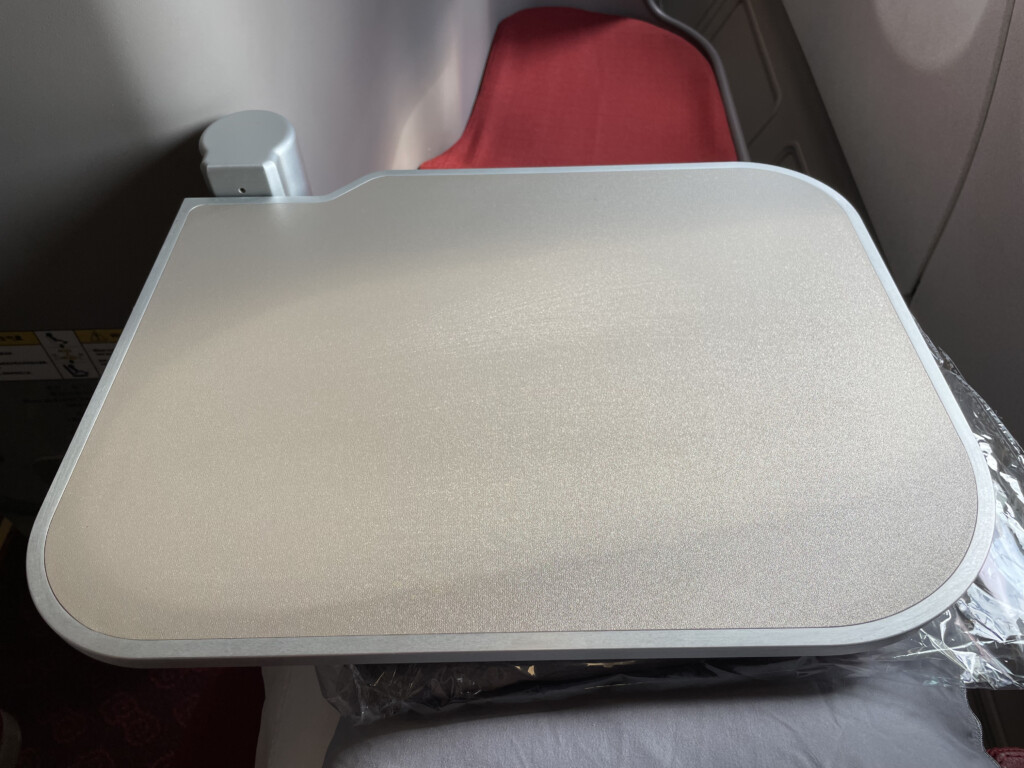
Hong Kong Airlines A330 Business Class Tray Table
Also in front of me was a TV screen. This wasn’t working during my flight, though I’ve been told Hong Kong Airlines has reinstated their entertainment system in the meantime. I last flew Hong Kong Airlines in 2018, and don’t believe the entertainment system had been updated over COVID-19, so check out that review for how the entertainment system is like – it’s not particularly extensive or impressive.
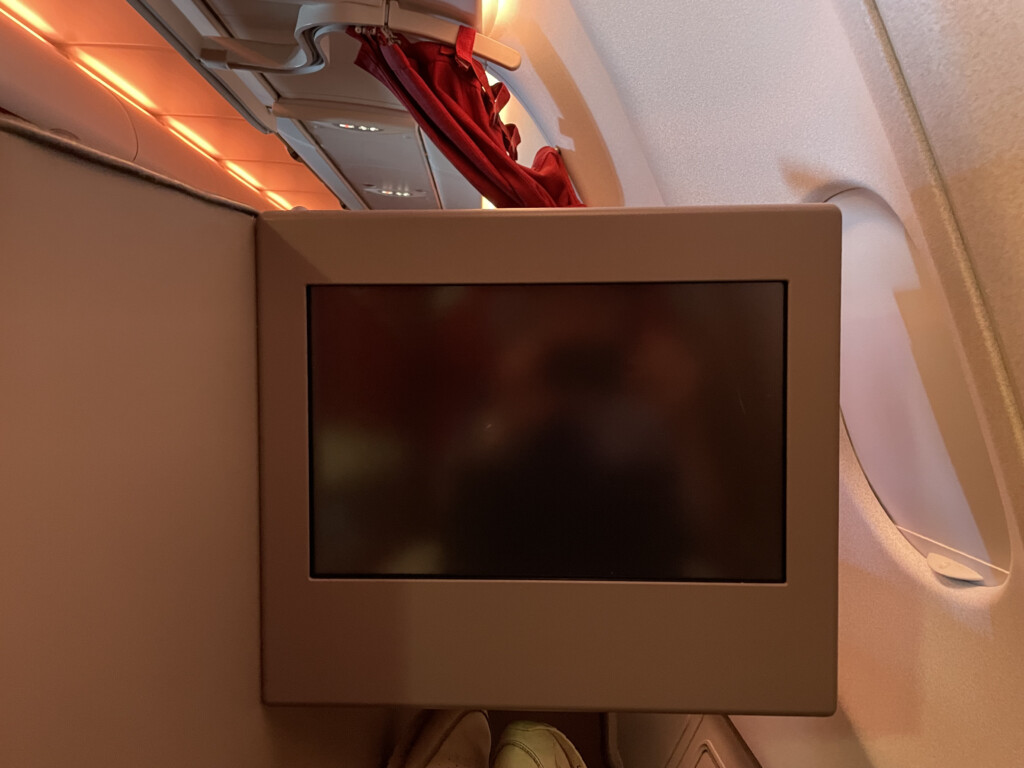
Hong Kong Airlines A330 Business Class TV Screen
While most seats didn’t feature nozzles, mine did, as I believe this seat would’ve been reserved as a crew rest seat on longer flights. I’m not sure why the airline didn’t just extend them to all seats. The cabin was sweltering hot during boarding in summer Tokyo weather, and the air nozzles helped with airflow at this time. Seat 19J also featured air nozzles, though I don’t believe any of the other seats had them.
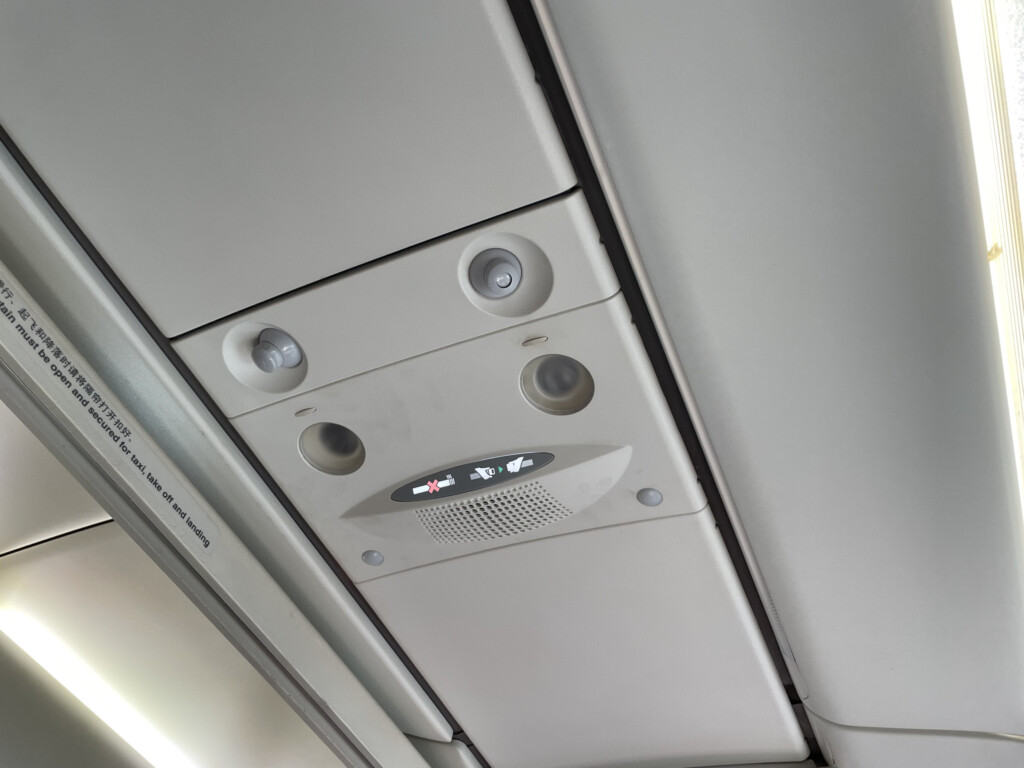
Hong Kong Airlines A330 Business Class Air Nozzles
This business class product is over a decade old at this point. We had no entertainment system, and I also didn’t like that there wasn’t USB charging available. However, this is a regional business class product with a fully flat bed, and that alone makes this product good value for money at the prices Hong Kong Airlines typically charges (more in line with what you’d expect from premium economy, or business class on a low-cost airline).
I’m not sure what Hong Kong Airlines will do if their cabin is due an update, given that they no longer have plans to expand to longhaul travel. Perhaps they won’t have to think that far, as they have plenty of planes to inherit from parent company Hainan Airlines. The airline even used to have A350s with reverse herringbone seats, though those have all been transferred off to different airlines.
Hong Kong Airlines A330 Economy Class
Since I was seated in the last row of business class, I was able to peek back to economy class once boarding started. Economy class looked fairly standard, as these are commonplace last-generation economy class seats with adjustable headrests – I’ll seek to fly Hong Kong Airlines in economy class someday.
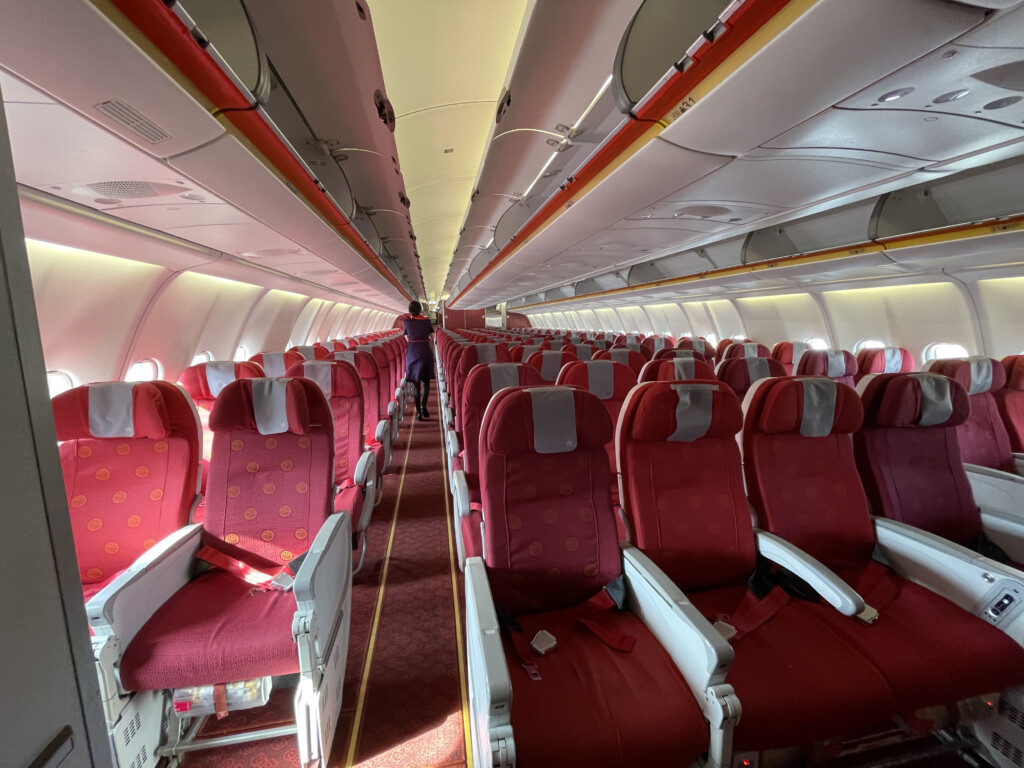
Hong Kong Airlines A330 Economy Class
Hong Kong Airlines A330 Business Class Amenities
Back at my seat, I found a pillow and a blanket. Hong Kong Airlines used to offer duvets in business class, even on shorthaul flights, but these have since been replaced by day blankets similar to those you’d find on other intra-Asia business class routes.
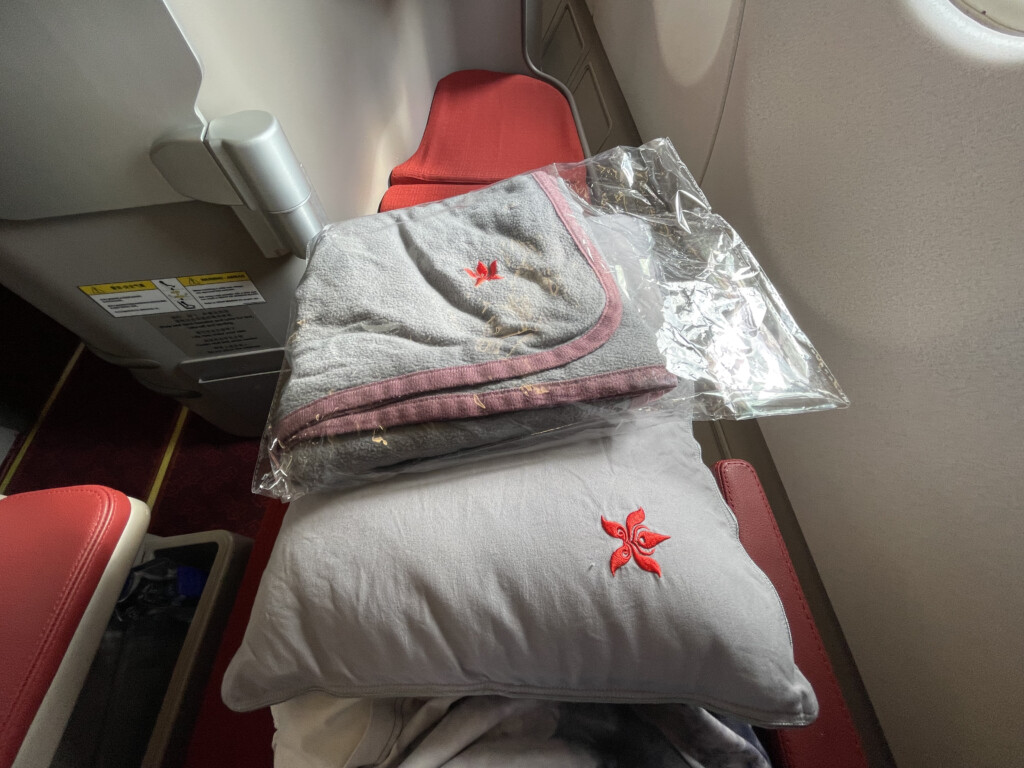
Hong Kong Airlines A330 Business Class Pillow and Blanket
I also found a bottle of water at my seat.
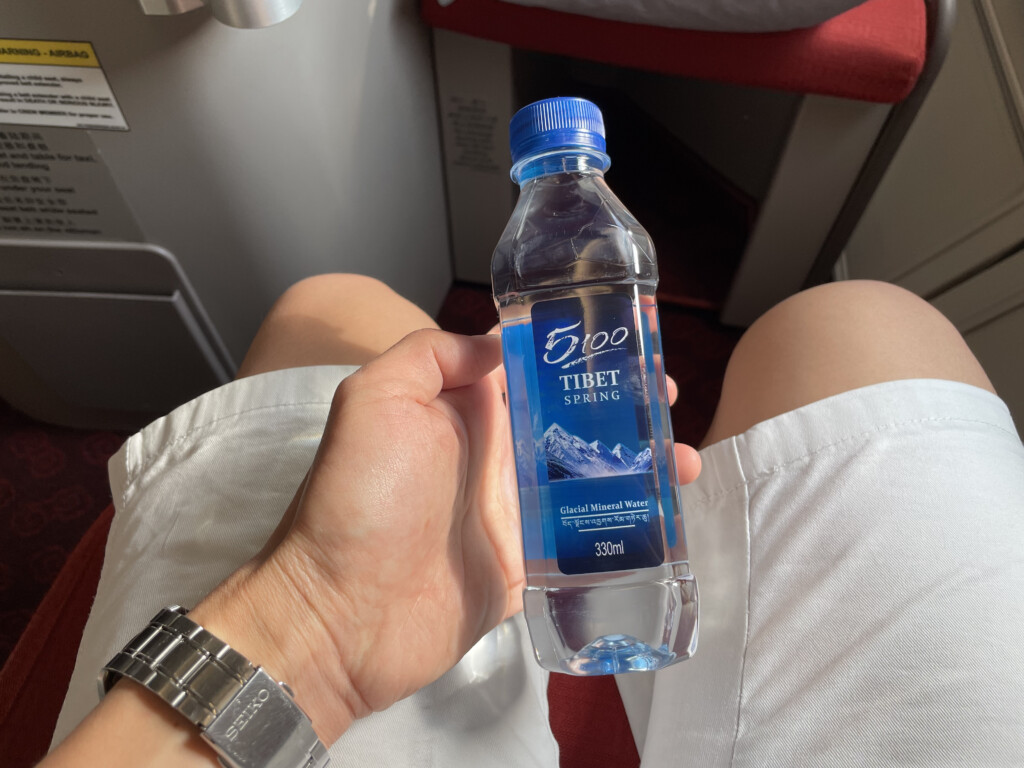
Hong Kong Airlines A330 Business Class Water
Hong Kong Airlines A330 Business Class Lavatory
I used the lavatory shortly after boarding. Hong Kong Airlines has three business class lavatories for business class passengers, one of which is at the front of the cabin. The lavatories have red wallpaper, but are otherwise pretty standard.
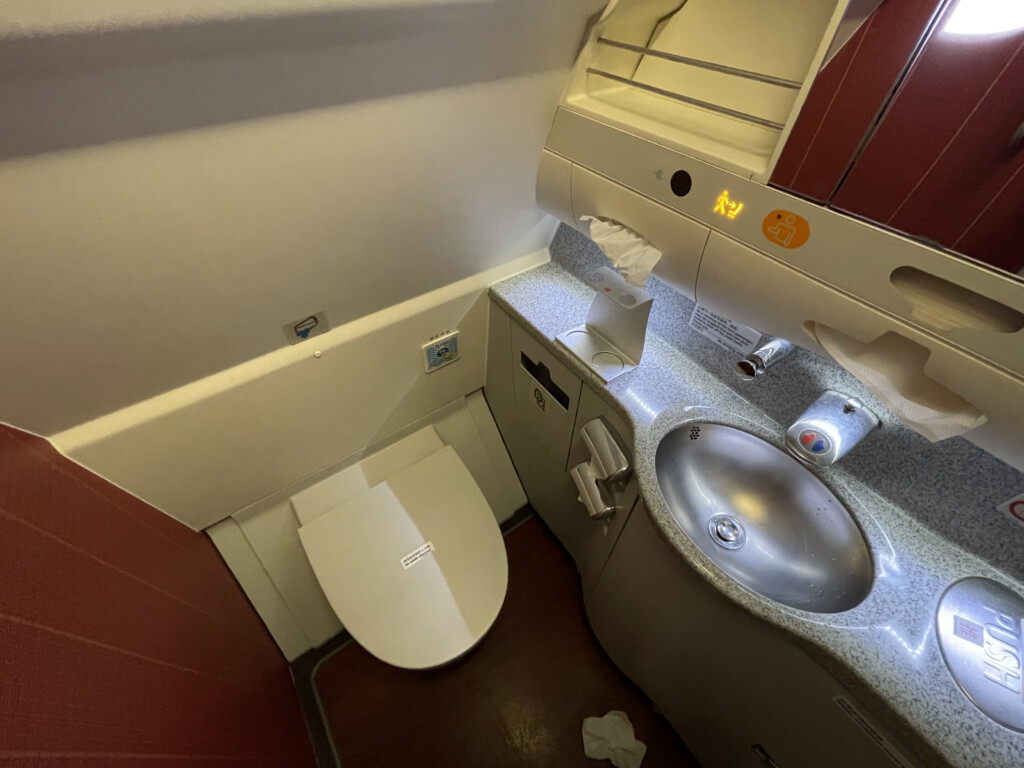
Hong Kong Airlines A330 Business Class Lavatory
Hong Kong Airlines A330 Business Class Pre-Departure Service
Around 15 minutes after boarding, the crew came around offering a choice of water or apple juice. I chose apple juice, which was served in a small glass.
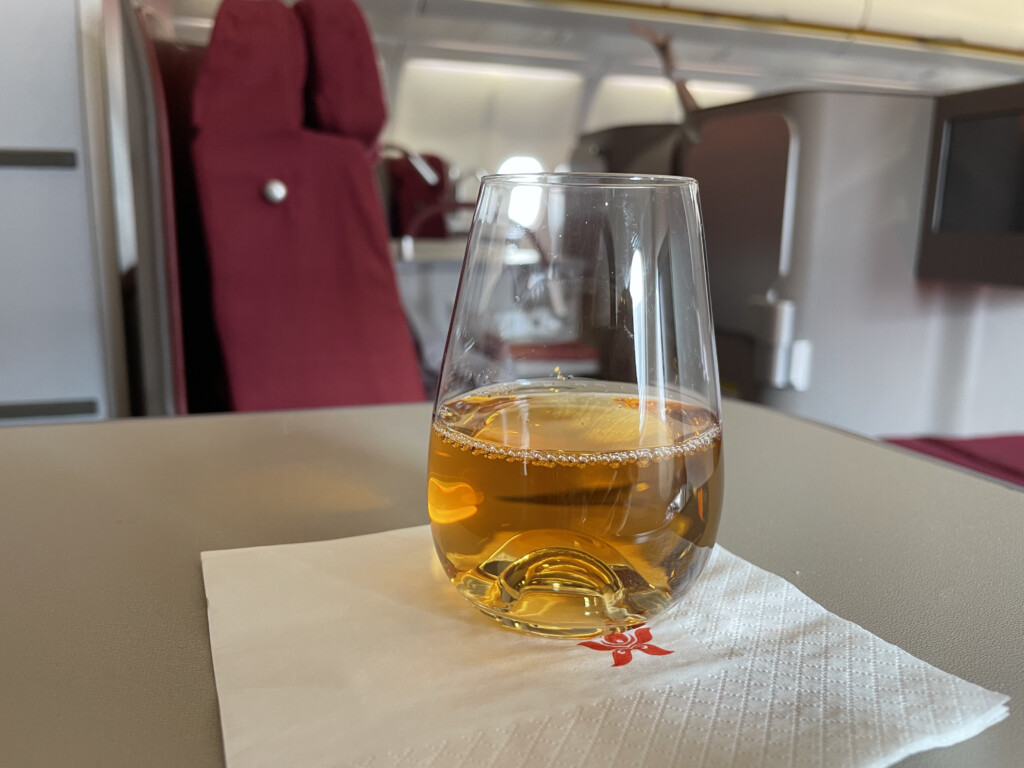
Hong Kong Airlines A330 Business Class Pre-Departure Beverage
Taking Off from Narita Airport
The crew offered to hang coats and stow bags throughout the boarding process. Boarding was completed at 3:50 PM, around five minutes before our scheduled departure.
The captain came onto the PA to announce our flight time of 4h 15m, explaining that the weather would be nice throughout the flight, though we’d occasionally encounter hits of turbulence. He mentioned that even though boarding had completed, we were waiting on cargo to load for a further five minutes, then we’d taxi for 10-15 minutes before taking off. Hong Kong Airlines really seems schedule-pad this flight, given that the flight time was blocked at 5h 5m (it rarely ever seems to take that long, especially in summertime).
We pushed back at around 4:05 PM, 10 minutes after our scheduled departure time.
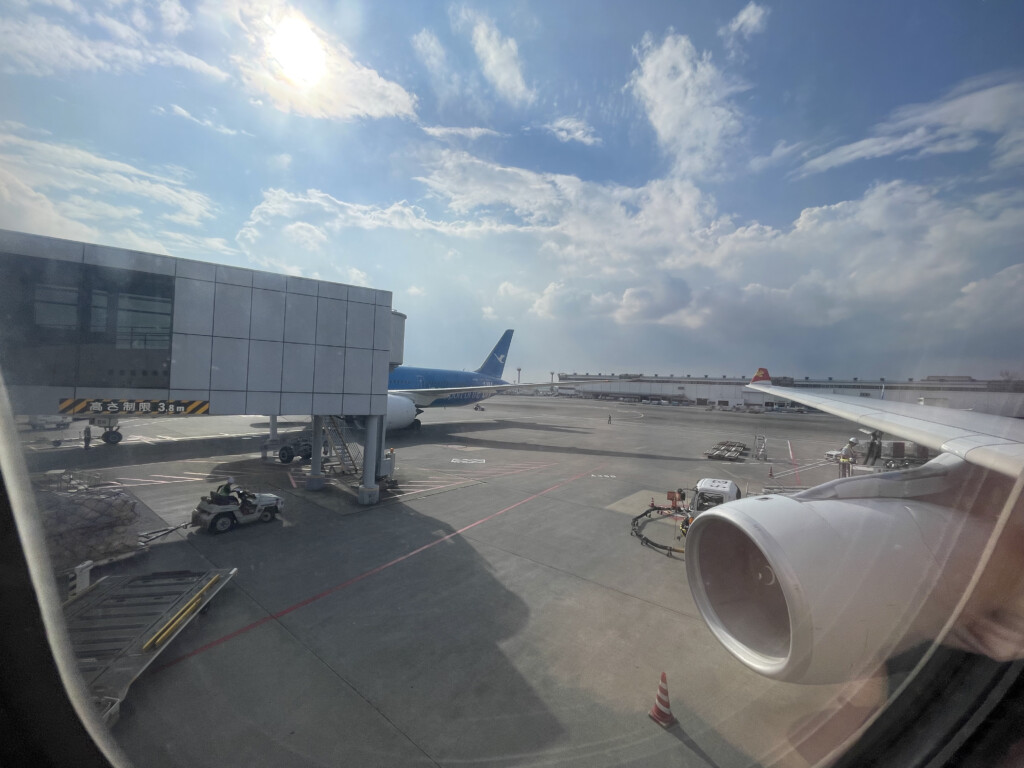
Pushing back from Tokyo Narita Airport
At this time the crew completed a manual safety demonstration. After this, they came around to take meal orders. Meals were shown on a laminated card, with photos – there was no menu provided.
I noted that once the captain said “cabin crew, seats for takeoff”, the crew would sit in the empty business class seats in my row. I wonder if that was specific to this flight – were the jumpseats not working? If not, what if the flight was full?
We took off at 4:20 PM, after a 15 minute taxi. Takeoff was from runway 16R, and we veered right after hitting the coastline. As sunny as it was, unfortunately it wasn’t the clearest day, so visibility was on the low side.
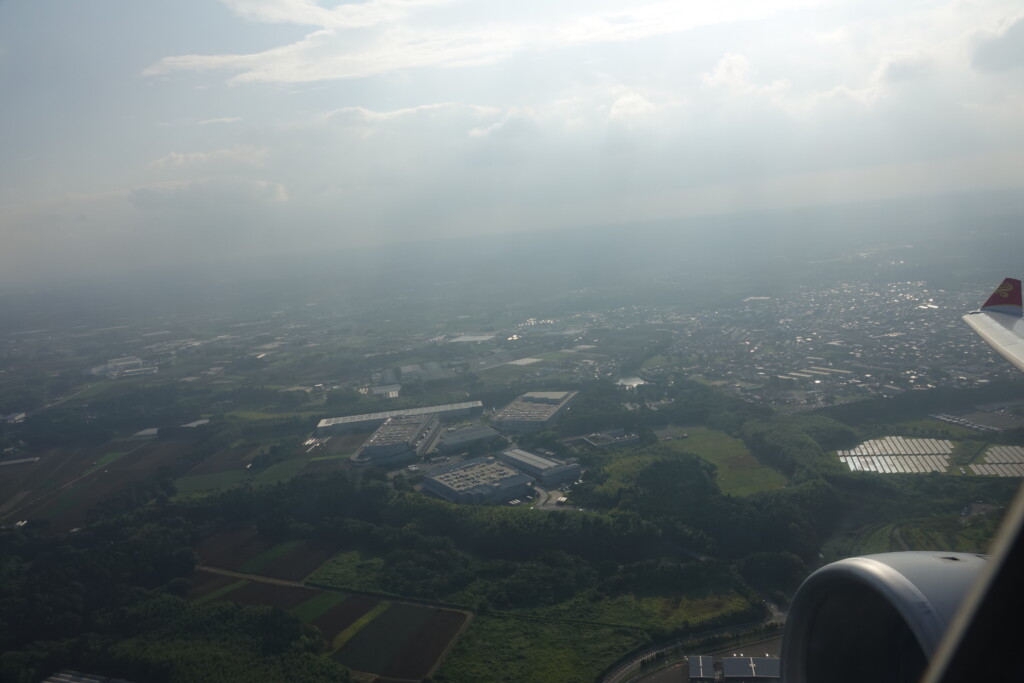
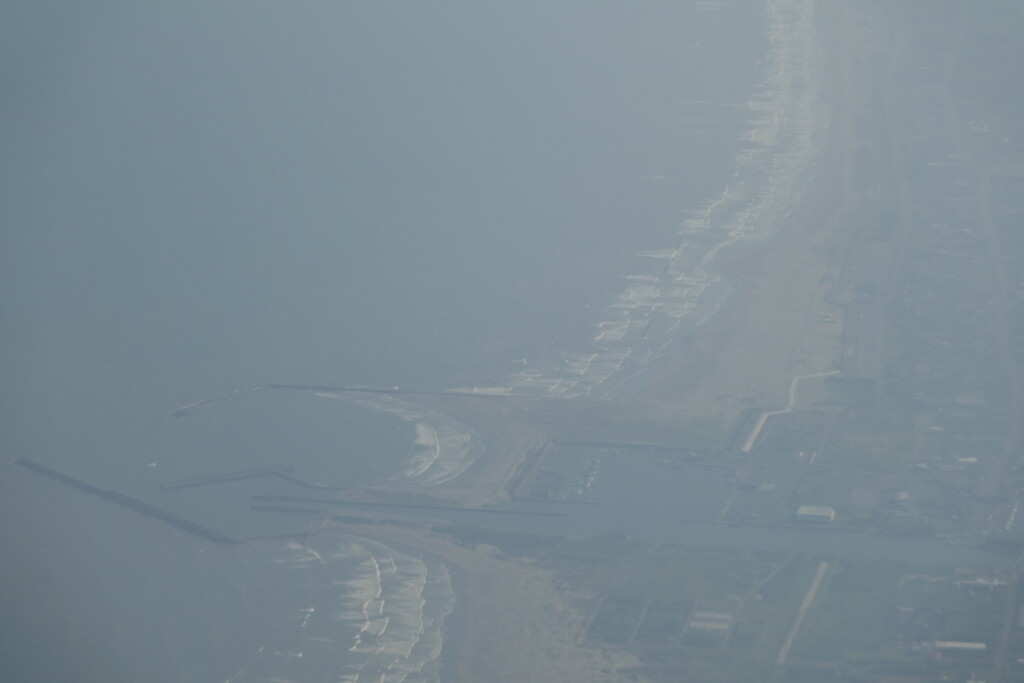
Takeoff from Narita Airport
The crew put on mood lighting once we reached cruising altitude.
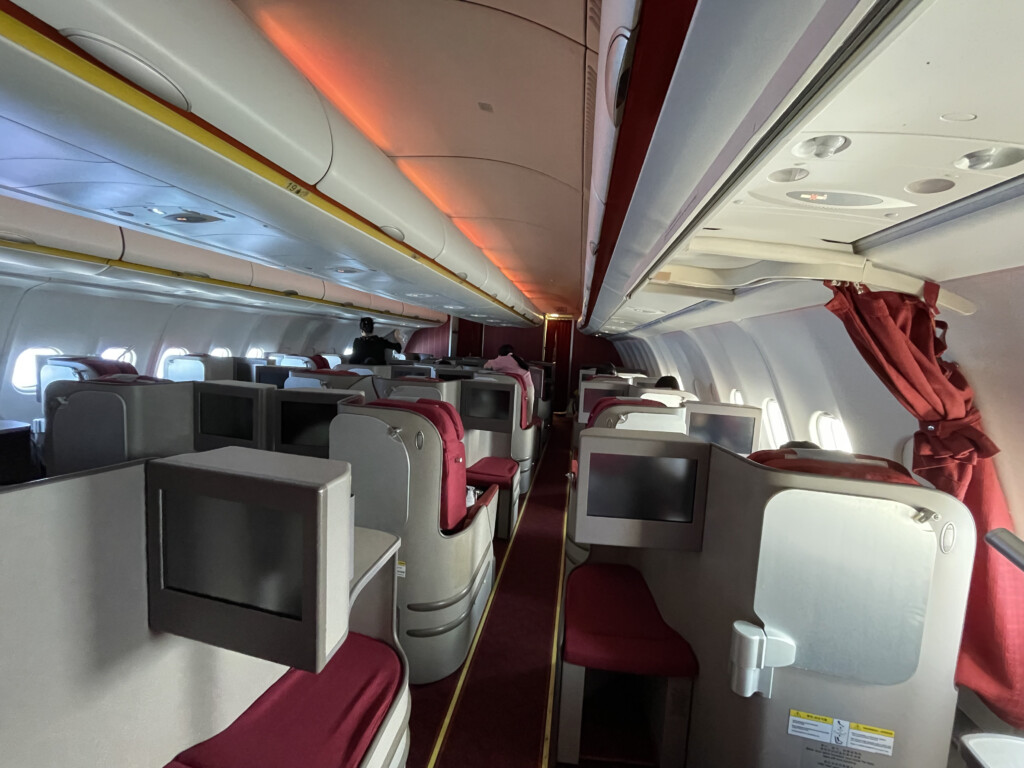
Hong Kong Airlines A330 Business Class Mood Lighting
Hong Kong Airlines A330 Business Class Meal Service
The meal service commenced around 25 minutes after takeoff. We were first asked if we’d like anything to drink. I decided to order a coffee, and liked the presentation, despite the fact that I definitely didn’t need to be served this many sugars.
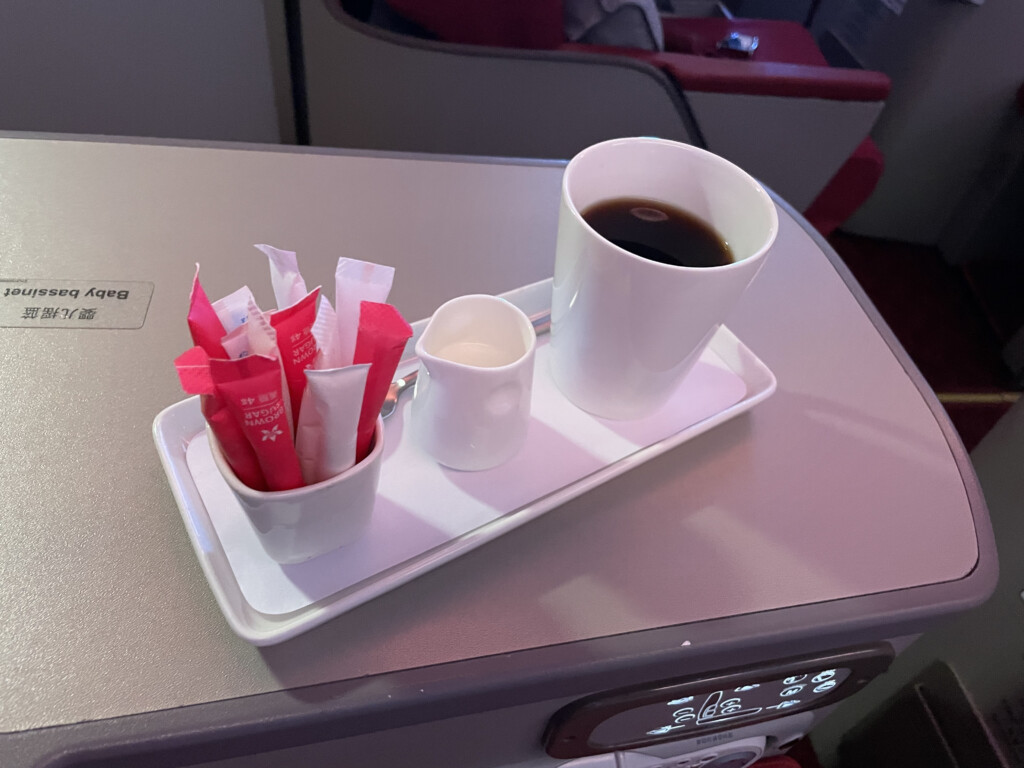
Hong Kong Airlines A330 Business Class Pre-Meal Service Beverage
The meal service was done entirely on trays – no trolleys were used. The three menu items were as follows:
- Shrimp and cheung fun
- Beef cheek
- Vegetarian wellington (phrased as a “western veggie meal”)
A single tray was presented to me around 35 minutes after takeoff, consisting of shrimp cheung fun (as I’d ordered), a pre-packaged croissant, and some grapes. The main course itself was okay – on the bland side, though totally fine, and I liked that they had Lee Kum Kee soy sauce. While I had much more elaborate meal services on my two flights (on similar routes) with Hong Kong Airlines in the past, I felt like this tasted better, despite not feeling particularly premium with the pre-packaged croissant and grapes.
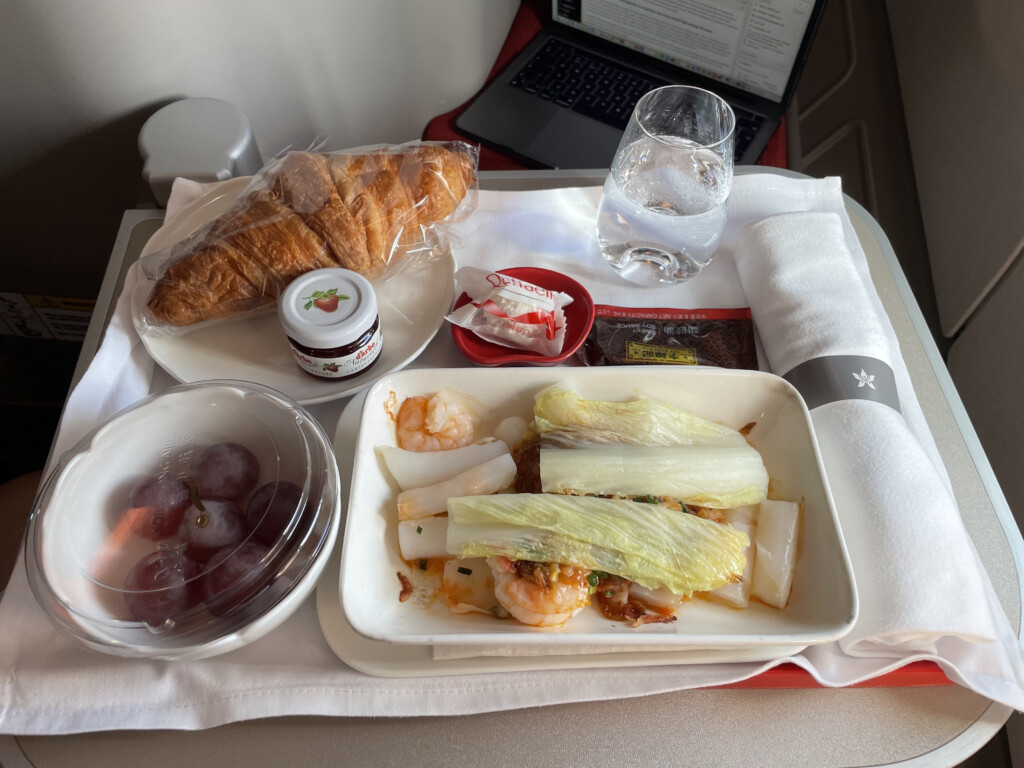
Hong Kong Airlines A330 Business Class Meal
Unfortunately my parents didn’t enjoy their beef cheek much.
There’s definitely some cost-cutting done here – Hong Kong Airlines used to offer a starter, main course, and dessert on flights of this length. This wasn’t too sustainable, and I’d rather have one well-executed dish on a flight of this length. I’d say Hong Kong Airlines is on the way there, and could use their extra budget to touch up what they serve the main course with.
Mood Lighting in Hong Kong Airlines Business Class
We were treated to a nice sunset after the meal service.
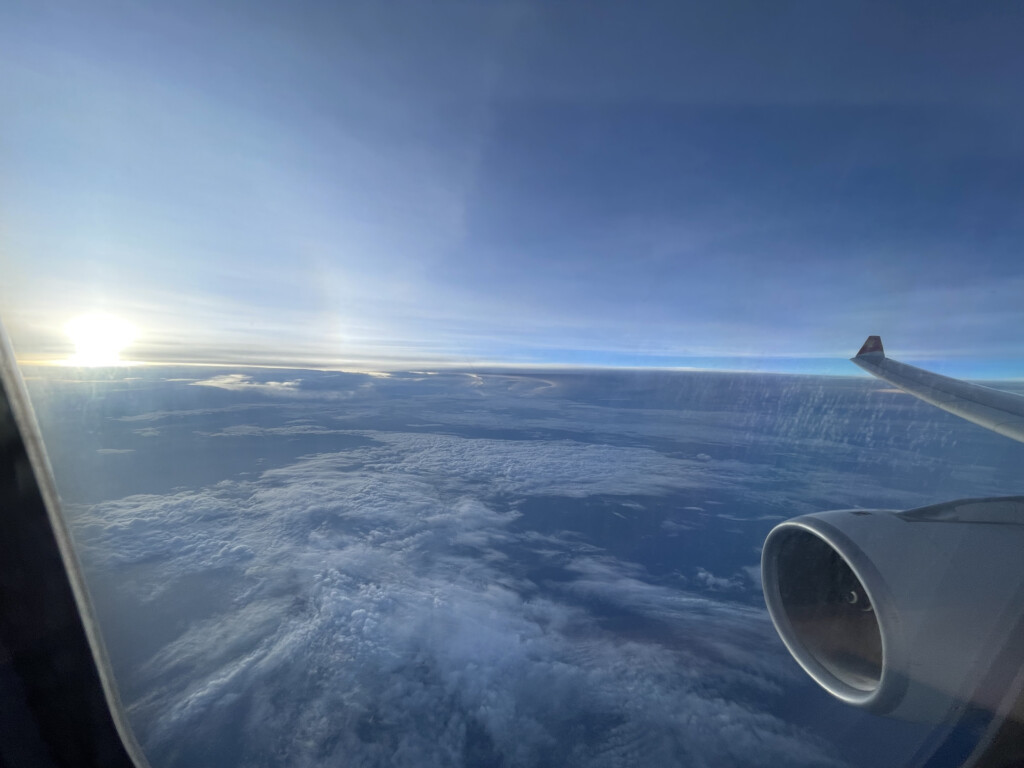
Sunset from Hong Kong Airlines A330
The mood lighting in the cabin was turned on to reflect this.
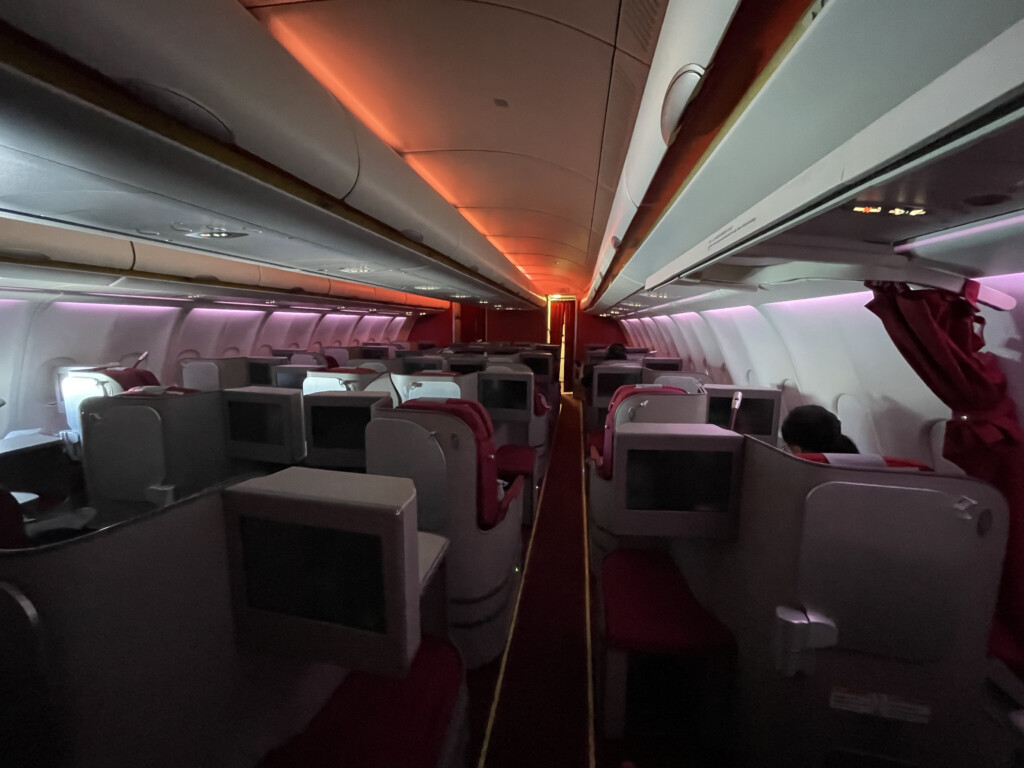
Hong Kong Airlines A330 Business Class Mood Lighting
Soon after, the cabin lights were turned off, so that people could rest. I’d note that although seat 20K is generally my preferred seat (it’s at the back of the cabin giving you some privacy, and in this case had some extra storage space where a bassinet would be), I’d generally recommend against it if you’re trying to sleep on the flight, because there’s lots of galley light.
Hong Kong Airlines A330 Business Class Service
The cabin crew on this flight were polished, and carried out a service that felt premium. For example, trays were brought directly to my seat, meal orders were taken before takeoff, and a crewmember would open the door to the bathroom whenever they saw someone approaching. The crew would also come around to ask if I needed anything, and were thoughtful – since I had my first coffee black, when I asked for a second coffee I was asked whether the crewmember could just serve a black coffee straight up. When they realised I’d assigned my family the “real” window seats, they asked whether we’d have wanted to switch to be closer together, though we declined.
I’d have expected morale at the airline to be weird given the hard time the airline has had, though I didn’t find that to be the case on this flight.
Landing into Hong Kong Airport
At around 6:30 PM Hong Kong time, the captain came onto the PA to announce fine 33°C weather conditions in Hong Kong, and that we’d be imminently descending. The crew then announced that based on Department of Health rules, anyone showing monkeypox symptoms would have to self-report at immigration.
Our approach into runway 25R meant that we had great views over Hong Kong, though unfortunately I was seated on the right side, so only had views of parts of the New Territories, as well as Shenzhen in the distance.
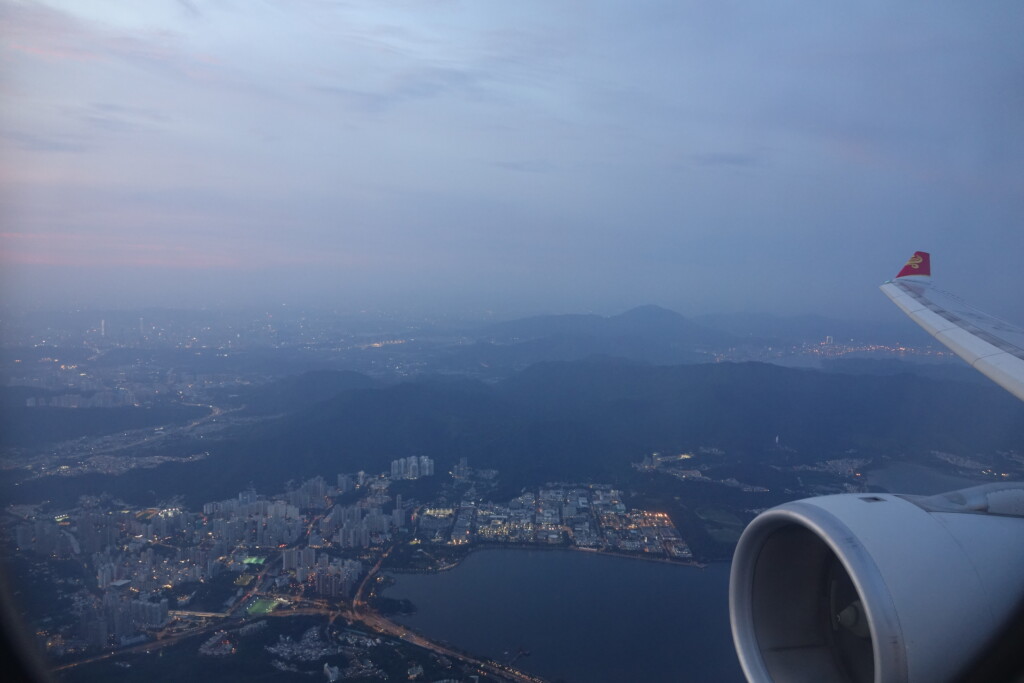
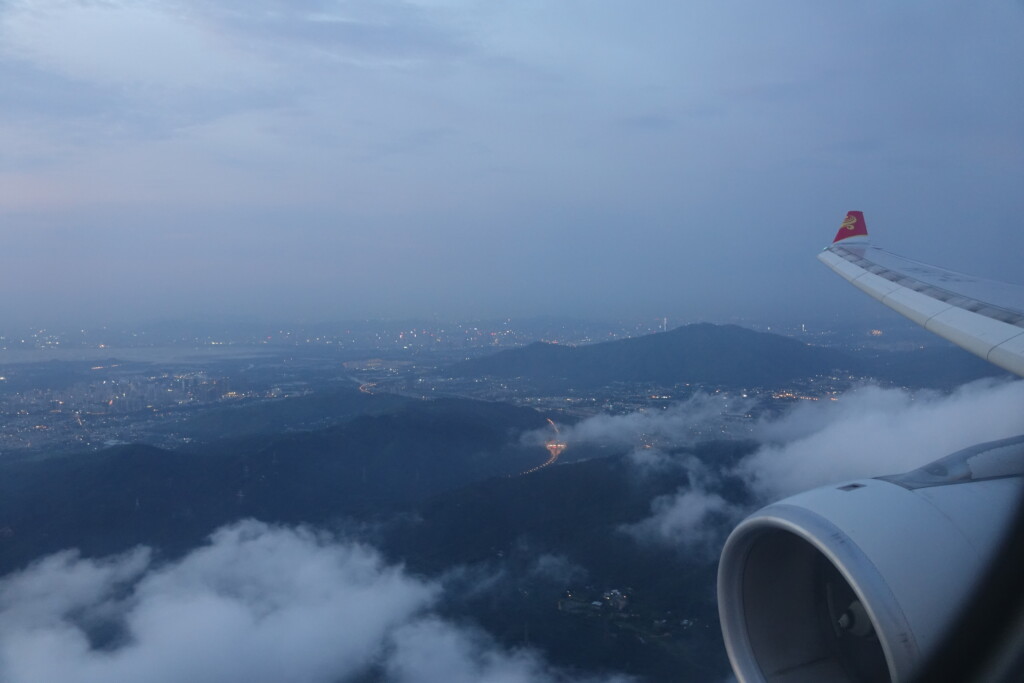
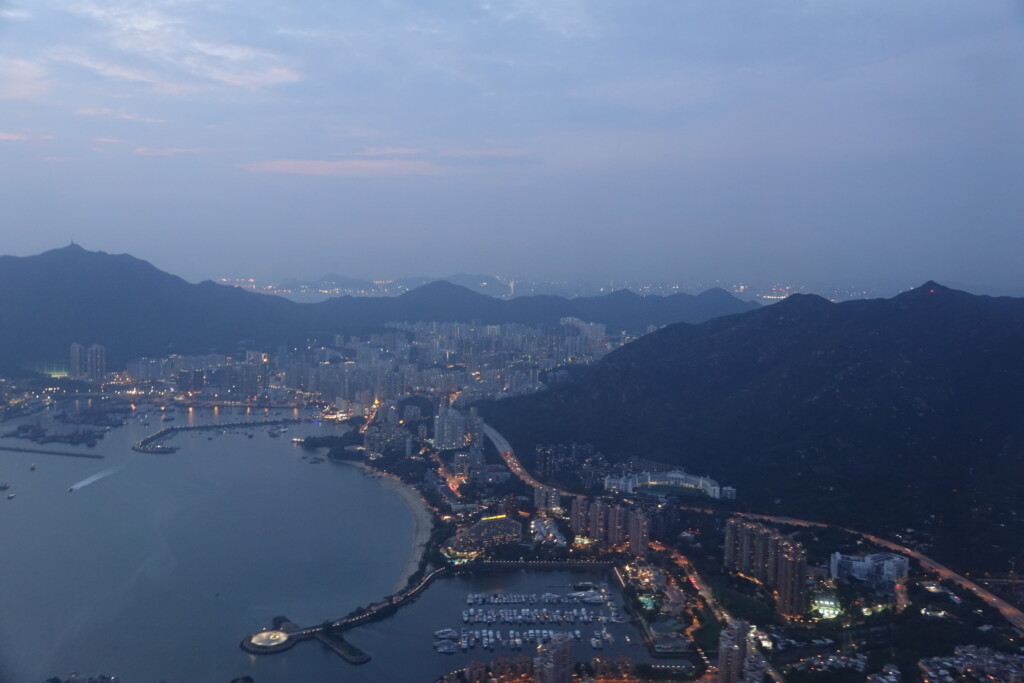
Views upon landing into Hong Kong
We parked at gate 28 by 7:25 PM, 35 minutes before our scheduled arrival time, and were on our way back. By 8 PM (scheduled arrival time) we were already on a taxi on the way home.
Conclusion: Hong Kong Airlines’ A330 Business Class
My flight on Hong Kong Airlines was perfectly fine. It wasn’t memorable by any means – it was nice to get a flat bed, though the product is aging, and the food and amenities were nothing to write home about. However, I don’t actually think that’s an issue, as this isn’t their main value-add.
The airline’s been trying to shift their brand identity towards more of a hybrid carrier, and funnels extra capacity at comparatively low prices to high-demand leisure destinations in Asia. They’ve recently brought back their inflight entertainment, though they have no plans to invest in WiFi; I also doubt they’ll return to a three-course meal service structure with menus in business class soon. However, the USP is that you’ll get a flat bed on a sub-6 hour flight generally at premium economy prices. I don’t think the airline is trying to cater to the business traveler that already has to choose between Cathay Pacific and Singapore Airlines on a four-hour flight.
With the prices they charge in business class, I’m not sure how much more they need to invest in order to make their product competitive? They’re already able to grasp demand from leisure destinations, given how high business class pricing can otherwise be intra-Asia, especially to Korea, Japan, Bali, and the Maldives. It wouldn’t make sense for them to invest in amenity kits or WiFi – if anything, I’d suggest they could try and implement free messaging, streaming entertainment, improve their entertainment system, or perhaps aggressively advertise their baggage allowance so they’re known for being Hong Kong’s “premium” leisure carrier (as the true low-cost carrier crown has been taken by HK Express). I’d be keen to try their economy class out someday, as I feel like that would give me a better idea of Hong Kong Airlines’ new brand and direction.
If the price was right, I wouldn’t hesitate to fly Hong Kong Airlines again.
Have you flown Hong Kong Airlines before?
